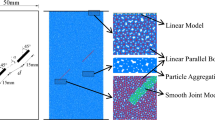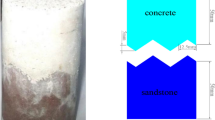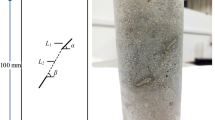Abstract
The sprayed concrete and surrounding rock will be impacted by seismic waves, air shock, and flying rock created by the drilling and blasting process used in mine and tunnel construction. The dynamic compression behaviors of concrete–rock combined body with six different inclination degrees (0, 30°, 45°, 60°, 75°, and 90°) were numerically simulated using LS-DYNA and the Holmquist–Johnson–Cook constitutive model in this work. The effect of the confining pressure (ECP) and strain rate (ESR) on the responses of the 3D meso-combined body were analyzed. Results indicated that the compressive strength of the combination can be improved, while the peak strain is lowered by increasing the contact inclination angle. The inclination dip determines the eventual failure mechanism of the specimens, and the final failure modes of the composite specimens with different dip angles can be divided into splitting failure, shear-compression composite failure, and shear failure. Finally, calculation results were compared with theoretical data published by R.E. Sheriff (1996). The research results are helpful to understand the dynamic failure law of lining confining pressure structure.
















Similar content being viewed by others
References
Du F, Wang K (2019) Unstable failure of gas-bearing coal-rock combination bodies: insights from physical experiments and numerical simulations. Process Saf Environ Prot 129:264–279
Dong X, Karrech A, Elchalakani M (2020) 3D bolted cohesive element for the modelling of bolt-reinforced rough rock-shotcrete interfaces. Comput Geotech 125:103659
Forti T, Batistela G, Forti N, Vianna N (2020) 3D Mesoscale finite element modelling of concrete under uniaxial loadings. Materials 13(20):4585
Fan XR, Luo N, Yuan YS, Liang HL, Zhai C (2021) Dynamic mechanical behavior and damage constitutive model of shales with different bedding under compressive impact loading. Arab J Geosci 14(17):1–18
Gutiérrez-Ch JG, Senent S, Melentijevic S, Jiménez R (2018) Distinct element method simulations of rock-concrete interfaces under different boundary conditions. Eng Geol 240:123–139
Gutiérrez-Ch JG, Melentijevic S, Senent S, Jimenez R (2020) Distinct element method simulations of rock-socketed piles: estimation of shaft resistance considering socket roughness. J Geotech Geoenviron Eng 143(12):04020133
Hokka M, Black J, Tkalich D, Fourmeau M, Kane A (2016) Effects of strain rate and confining pressure on the compressive behavior of Kuru granite. Int J Impact Eng 91:183–193
Hong L, Gu X, Lin F (2014) Influence of aggregate surface roughness on mechanical properties of interface and concrete. Constr Build Mater 65:338–349
He Z, Song Y (2010) Triaxial strength and failure criterion of plain high-strength and high-performance concrete before and after high temperatures. Cem Concr Res 40(1):171–178
Hao Y, Hao H (2013) Numerical investigation of the dynamic compressive behaviour of rock materials at high strain rate. Rock Mech Rock Eng 46(2):373–388
Holmquist TJ, Johnson GR (2011) A computational constitutive model for glass subjected to large strains, high strain rates and high pressures. J Appl Mech 78(5)
Huang X, Qi S, Xia K et al (2016) Propagation of high amplitude stress waves through a filled artificial joint: an experimental study. J Appl Geophys 130:1–7
Khanlari G, Rafiei B, Abdilor Y (2015) Evaluation of strength anisotropy and failure modes of laminated sandstones. Arab J Geosci 8(5):3089–3102
Jiang Q, Yang Y, Yan F, Zhou J, Li S, Yang B, Zheng H (2021) Deformation and failure behaviours of rock-concrete interfaces with natural morphology under shear testing. Construct Build Mater 293: 123468
Liu XQ, Wang G, Liu TT, Lin MQ, Lei HX, Mandal AK (2020) Study on dynamic mechanical properties of phosphate rock through experimental tests and mesoscale simulation. Arab J Geosci 13(18):1–10
Li G, Ma F, Guo J, Guo J Zhao H, Liu G (2020) Study on deformation failure mechanism and support technology of deep soft rock roadway. Eng Geol 264:105262
Li Y, Zhai Y, Liu X, Yang W (2019) Research on fractal characteristics and energy dissipation of concrete suffered freeze-thaw cycle action and impact loading. Materials 12(16):2585
Miled K, Sab K, Le Roy R (2007) Particle size effect on EPS lightweight concrete compressive strength: experimental investigation and modelling. Mech Mater 39(3):222–240
Ouyang H, Chen X (2020) 3D meso-scale modeling of concrete with a local background grid method. Construct Build Mater 257:119382
Saksala T, Hokka M, Kuokkala V (2017) Numerical 3D modeling of the effects of strain rate and confining pressure on the compressive behavior of Kuru granite. Comput Geotech 88:1–8
Selçuk L, Aşma D (2019) Experimental investigation of the rock–concrete bi materials influence of inclined interface on strength and failure behavior. Int J Rock Mech Min Sci 123:104119
Sheriff RE, Geldart LP (1996) Exploration Seismology
Torsæter M, Todorovic J, Lavrov A (2015) Structure and debonding at cement–steel and cement–rock interfaces: effect of geometry and materials. Constr Build Mater 96:164–171
Teng J, Tang J, Wang J, Zhang Y (2018) The evolution law of the damage of bedded composite rock and its fractal characteristics. Chin J Rock Mech Eng 37:3263–3278
Wang B, Li Y, Yang C, Zhang G (2015) Influences of interface inclination on mechanical properties of composite bedded physical model material. Rock Soil Mech 36:139–147
Wang P, Jia H, Zheng P (2020) Sensitivity analysis of bursting liability for different coal-rock combinations based on their inhomogeneous characteristics. Geomat Nat Haz Risk 11(1):149–159
Wang EY, Zhao EL (2013) Numerical simulation of electromagnetic radiation caused by coal/rock deformation and failure. Int J Rock Mech Min Sci 57:57–63
Wang L (1985) Stress wave foundation. National Defense Industry Press, Beijing
Xu Y, Dai F, Xu NW, Zhao T, Zhou C (2016) Discrete element simulation of dynamic semi-circular bend flexure tests of rocks using split Hopkinson pressure bar. Arab J Geosci 9(9):1–13
Yan P (2018) Study on dynamic behavior and damage characteristics of shotcrete surrounding rock composite. China University of mining and Technology (Beijing)
Yang R, Li W, Fang S, Zhu Y, Li Y (2019) Experimental study on impact dynamic characteristics of layered composite rocks. Chin J Rock Mech Eng 38(09):1747–1757
Zhou Z, Shen Y, Zhang H, Wang Y, Yang H, Pan J, Wei X (2021) Sandstone-concrete interface debonding mechanism under freeze-thaw actions: fracture process and fracture criterion. Constr Build Mater 294:123526
Zhou H, Song M, Zhang C, Lu J, Shi L (2019) Effect of confining pressure on mechanical properties of horizontal layered composite rock. Rock Soil Mech 40(2):465–473
Zhao ZW, Wu B, Zhang ZY, Yu W (2021) Impact strength characteristics of granite under combined dynamic and static loading conditions. Arab J Geosci 14(2):1–7
Zhou XQ, Hao H (2008) Modelling of compressive behaviour of concrete-like materials at high strain rate[J]. Int J Solids Struct 45(17):4648–4661
Zhao ZH, Ma WP, Fu XY, Yuan JH (2019) Energy theory and application of rocks. Arab J Geosci 12(15):1–26
Acknowledgements
The authors would like to acknowledge financial support from the National Natural Science Foundation of China (No. 41772277 and 41941019), the Fundamental Research Funds for the Central Universities, CHD (No. 300102269401), and “111” Center, program of the Ministry of Education of China (No. B18046).
Author information
Authors and Affiliations
Corresponding author
Ethics declarations
Conflict of interest
The authors declare that they have no competing interests.
Additional information
Responsible Editor: Zeynal Abiddin Erguler
Rights and permissions
About this article
Cite this article
Gao, H., Zhai, Y. Numerical investigation of the concrete–rock combined body influence of inclined interface on dynamic characteristics and failure behaviors. Arab J Geosci 15, 435 (2022). https://doi.org/10.1007/s12517-022-09749-1
Received:
Accepted:
Published:
DOI: https://doi.org/10.1007/s12517-022-09749-1




